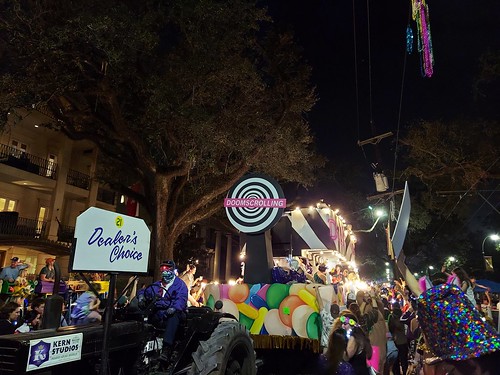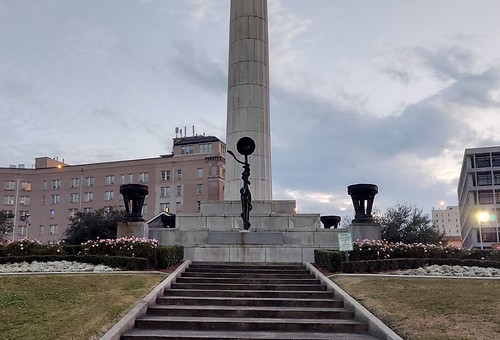
A Krewe du Vieux sub-krewe of TOKIN float sports the mock Entergy slogan "We're not happy until you're not happy"
So a few weeks ago, when we last mentioned that we wanted to do more posts, we were reminiscing about the fast one Walt Leger and LaToya Cantrell pulled on everybody when their so called "fair share" legislation actually empowered the tourism moguls to steal public money under the false pretense of funding infrastructure. Since then (on that very day, in fact) another, and similarly dubious, infrastructure deal was collapsing.
This story stretches back to last summer when the city announced a deal with Entergy whereby the utility would finance construction of a new substation supposed to create more reliable power generation for pumps operated by the Sewerage and Water Board. The announcement came right about the time of the mayor's reelection campaign launch. Her campaign twitter account hailed it as "Promises kept." But, now, we learn that Entergy has broken its part of that promise.
Entergy said in a prepared statement on Monday that it could not
afford its portion of the $74 million deal, at least for now. That could
change if “financial stability is restored,” the statement said.
Under the terms of a deal
announced last June, the city was set to kick in $22 million from a
bond issue to pay for frequency changers that convert Entergy power to
an older standard compatible with the city’s pumps. State construction
financing would contribute more than $20 million to the project, with
Entergy handling the rest.
Entergy originally only committed to $34 million up front. But even that wasn't really a plan to spend their own money.
The $74 million will come from three different sources. The initial $34
million investment to build the substation will come from Entergy. The
Sewerage and Water Board will then pay Entergy back for that investment
over time.
So what they are saying right now is they are too cash poor to just raise the upfront capital? $34 million? That doesn't sound right. What could have happened between June and now to cause this highly profitable mega-corporation to suddenly not have $34 million to throw at something? And don't say Hurricane Ida, you frauds....
Oh dammit..
Entergy said the cost of repairing its own system from Hurricane Ida damage made fronting the money too difficult right now.
“Entergy New Orleans was discussing the unusual step of financing a
substation for the S&WB given its financial condition,” Entergy
spokeswoman Lee Sabatini said. “Subsequent to those initial
negotiations, Hurricane Ida hit Entergy New Orleans’ service area, which
further strained the company’s own financial condition by having to
fund large amounts of storm costs with uncertainty around the timing and
mechanism to recover those costs.”
Oh no Ida ate up all the money. Hey, did Entergy still manage to pay out huge sums to shareholders in dividends and buybacks after Ida? Do we even have to ask?
Last month, Entergy New Orleans revealed it was pulling funding
from a vital city project to shore up the city’s flood defenses. Citing
the massive cost of recovering from Hurricane Ida, the company said it
could no longer fulfill its commitment to loan $30 million to the
Sewerage and Water Board.
Four days later, the utility’s parent company, Entergy Corp.
announced quarterly shareholder dividend payments at $1.01 per share,
totaling $202 million.
The two announcements, side by side, are indicative of what several
utility experts told The Lens is a broader trend for Entergy, and for
utility monopolies across the country — insulating shareholders from
risk and shifting the burden to customers.
Incredible. Why on earth would Entergy prioritize parasitic profit taking over the service needs of the ratepayers from whom those profits are extracted? Well, see, that's actually how it's supposed to work.
Like other utility companies, Entergy stock doesn’t offer investors big
growth potential. To make up for it, the company dedicates a huge
portion of its annual earnings — over 60 percent on average — to ensure
its quarterly shareholder payments remain steady and predictable. In a
statement, an Entergy spokesperson said that keeping the dividend high
and protecting the stock price also benefits customers by making it
cheaper for the company to raise cash for infrastructure investments.
See? Keep the stockholders nice and happy and they will reward you with "infrastructure investments." Like, for example, the new substation that will... wait a minute....
Well anyway it's complicated. You just keep paying your bill. Whatever amount it says on there.
According to the presentation, Entergy New Orleans boasts a 99.1
percent accuracy rate on bills. Leslie Dennis, who works in Entergy’s
billing department, said that the company would try to get that number
even higher by expanding auditing and improving staff training.
“We recognize we may have some human performance errors,” Dennis said.
But the presentation stopped short of explaining, beyond the issue of
accuracy, whether customer bills are actually rising. Sandra
Diggs-Miller, Entergy New Orleans’ vice president of customer service,
implied that recent customer complaints about high bills have more to do
with rising expectations, rather than rising bills.
“We recognize that our customers’ expectations are evolving at a pace
that admittedly outpaces the level of engagement we’re providing as a
company. The billing complaints we’ve seen are certainly a byproduct of
that.”
It is time to get your expectations back down to a reasonable pace that Entergy can keep up with. In other words, try and be more like the New Orleans city council. Already they have adjusted their expectations all the way back down so far that they are ready to subsidize Entergy's shareholder bonanza by spending COVID relief funds allocated to the city by the American Rescue Plan.
Thursday’s measures still have to be passed by the full City Council.
At Thursday’s budget committee* meeting, Councilwoman Helena Moreno
said the new funding presents an even better deal than the original
plan. She pointed out that under the financing plan in the original proposal, the Sewerage and Water Board would have to pay Entergy back $85 million over 15 years.
“This to me is a no-brainer,” Moreno said. “If we look at this
project, and compare it to the original deal that we had with Entergy,
this is actually much more beneficial to the Sewerage and Water Board.”
There is some apprehension, however, from Mayor LaToya Cantrell’s
administration. While the administration says it’s supportive of using
federal funds for the substation, it had concerns about the exact
financing model proposed by the council.
The Cantrell administration is non-committal because they are trying to use the ARP money to hire more cops which is probably a worse idea than covering for Entergy. But that still doesn't make Helena Moreno's proposal a "no-brainer." It's true what she says there about the original plan requiring SWB to pay Entergy back over time. That was one of our first complaints, in fact, back when the scheme was announced last year. But I don't think we should let any of that distract from the fact that we are still using public money to subsidize a ka-billion dollar private utility company specifically in order for it to continue paying out as much cash to its shareholders as possible. There is something fundamentally very wrong with that. And it's not just a matter of one local dispute over powering our antiquated pumps. Instead it is one small manifestation of a larger trend in public-private finance.
Here is a short article published in November by the economist Daniela Gabor. She is writing about the finance discussions at the COP26 international climate conference held in Glasgow last year. The thrust of the analysis is that central banks and governments have backed away from taking the necessary aggressive steps to mitigate climate change and instead turned the very fate of the planet over to private finance.
The macrofinancial politics of COP26 should be understood as status-quo
financial capitalism now entering its green age. Day three of the
Conference of the Parties was Finance Day, rather than green public
investment day, because of the growing political consensus in the Global
North that decarbonization must be finance-led. In a 2021 paper, I
termed this the Wall Street Consensus.
If the Washington Consensus had its most articulate ambassador in
economist John Williamson, the Wall Street Consensus has Mark Carney,
the head of the Glasgow Financial Alliance for Net Zero (GFANZ), the UN
Special Envoy for Climate Finance, and the intellectual author of the green turn in central banking.
GFANZ gave COP26 its big decarbonization number: USD 130 trillion “relentlessly, ruthlessly focused on net zero.” To put that number in perspective, at COP26 rich countries failed again to honor their pledge for USD 100 billion per year in climate finance for poor countries. There was greenwashing even in the headline number, since USD 130 trillion was not the estimated credit flow about to inundate green sectors, but rather the combined assets under management of GFANZ members, many issued to finance dirty activities.
But those USD 130 trillion would not find their way into climate-friendly activities, GFANZ members like BlackRock’s Larry Fink argued, without a little help. Of course, Larry Fink was not calling for mandatory decarbonization, but for public policy and private firms to work together on climate in the same way that they worked together on vaccines. John Kerry, the US Special Presidential Envoy for Climate, translated such calls for public-private partnerships into Wall Street Consensus lingo: “Blend the finance, de-risk the investment, and create the capacity to have bankable deals. That’s doable for water, it’s doable for electricity, it’s doable for transportation.”
This is the Wall Street Consensus mantra: the state and development aid, including multilateral development banks, should escort the trillions managed by private finance into climate or the Sustainable Development Goals asset classes. The state derisks or “blends” by using public resources (official aid or local fiscal revenues) to align the risk-return profile of those assets (“bankable projects”) with investor preferences or mandates. Transforming climate or nature into asset classes necessitates the commodification and financialization of public goods and social infrastructure, beyond water, electricity and transportation, and including housing, education, healthcare; these have to generate cash flows that pay institutional investors. The consensus understands the state as a derisking agent: its fiscal arm enters public-private partnerships to render them bankable by transferring some of the risks to the balance sheet of the sovereign, while its monetary arm protects investors from liquidity and exchange rate risk.
Reading through that one begins to see the ideology reflected in our local government's willingness to use federal funds of which it is a steward not for their ostensible purpose of building sustainable infrastructure but instead for propping up the finances of a private utility company. In essence, our politicians have ceased to understand that those goals are inherently in conflict. Instead, their purpose is to "de-risk" the investment of Entergy shareholders at the expense of US taxpayers (and, of course, Entergy ratepayers.) Wealth transfers upward, risk shifts downward. Nothing else is guaranteed for anyone. Adjust your expectations accordingly.



























